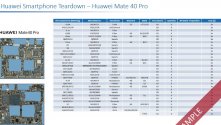I want to point out the RF chip & 5G modem aren't the same thing. SoC could come with 5G modem like Qualcomm Snapdragon X65 that comes with Snapdragon 8 or it could not, but RF Front end modules aren't the same as 5G modem as demonstrated hereI didn't mean to imply that all RF chips are in the SOC, only that all previous examples stuffed some 5G RFs into the SOCs and you would have to redesign to untangle that.
I just wanted to explain this is why there are conversations about 5G being part of the CPU. Huawei absolutely would have to develop their own external RF chips.
But as I already stated, the bigger problem was the filters that everyone was talking about. Which is now a solved problem. So unsurprisingly, Huawei is about to release new 5G phones.

notice that 5G modem interacts with both RF transceiver and mmWave antenna module
you can see with this Samsung phone. modem is at separate location vs various pamid modules & fem modules + various other mobile ICs. All have a place in circuit board

And finally for the last flagship 5G Huawei phone the Mate 40, you can just see how much American/Japanese components are in there

Sure, it uses Hisilicon 5G modem, but it also uses so much different RF components from different non domestic manufacturer. Aside from its own components, the only other domestic supplier it used was Switch from Maxscend
Again, Chinese smartphone makers try to integrate as many domestic suppliers as possible, but Maxscend & Vanchip really are not very capable. I'd imagine for most of this, Huawei has to replace them itelf. The filters are now likely made by memsonic and Maxscend and some CETC companies. It might also get tuners & switch from other suppliers, but most of the components has to be designed by Hisilicon. Although Vanchip claims to produce PAMID, I would imagine that just integrates foreign RF filters
